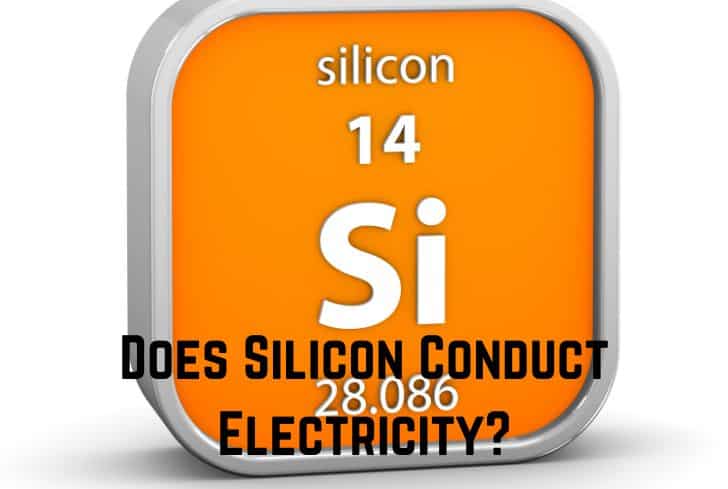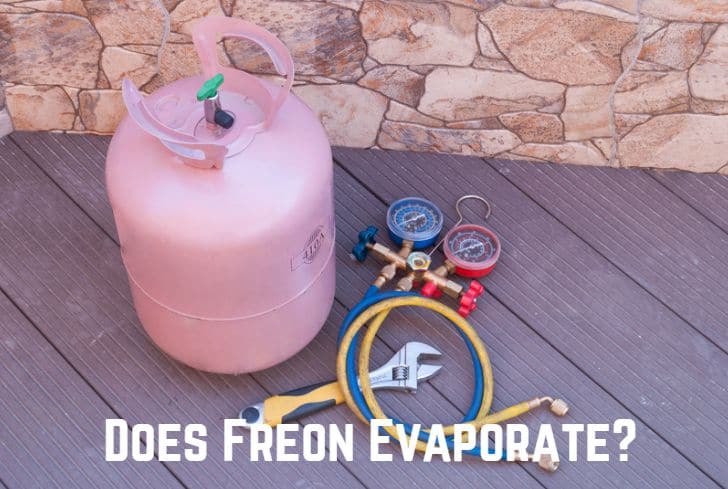Does Silicon Conduct Electricity? (And Is It a Semiconductor?)

Silicon is a chemical element with an atomic number of 14. It is a hard, brittle crystalline solid with a blue-grey metallic lustre. Silicon is the 8th most common element in the universe by mass, widely distributed in cosmic dust and planets. More than 90% of the earth’s crust comprises silicate minerals, making silicon the second most abundant element after oxygen.
Have you ever wondered if silicon is conductive? In this article, we are going to discuss just that. We will begin with the properties and uses of silicon. Then we will discuss its electrical conductivity in detail. We will also look at some other aspects of silicon, such as its interaction with heat and water.
Read: Is Glass Conductive?
Is Silicon a Conductor or Insulator?
Silicon is a semiconductor, meaning its electrical conductivity value falls between that of a conductor (like copper) and an insulator (like glass). Being a semiconductor, silicon can conduct electricity under certain conditions and it is used widely in electrical applications.
Let us first understand how electrical conduction works. For a material to conduct electricity, it must have free electrons that can move the electric charge from one place to the other. Metal ions form a giant structure known as the “sea of delocalized electrons”, which can move freely.
These free-moving electrons can transport the electric charge from one point to another, which is why metals are conductive in both solid and liquid states. Most non-metals (like glass), however, do not have free electrons and therefore do not conduct electricity.
Silicon is a semiconductor, so its electrical conductivity is less than that of conductors but more than that of insulators. Interestingly, the electrical resistivity of semiconductors falls as the temperature rises. In other words, when temperature increases, a semiconductor like silicon conducts greater electricity.
This is opposite to the way metals behave. For metals, a rise in temperature means a rise in electrical resistivity. So, when temperature increases, a metallic conductor like copper will conduct less electricity.
Keep reading to find out how silicon conducts electricity.
Properties of Silicon
These are the properties of silicon:
- Silicon is a member of group 14 in the periodic table. It has 14 electrons around the nucleus, out of which 4 are valence electrons in the outermost orbital. It is relatively unreactive.
- Silicon is a metalloid with a blue-grey lustre, and it is hard and brittle.
- It has a high chemical affinity for oxygen, and it was not discovered in its pure form until 1823 by Jöns Jakob Berzelius.
- Silicon has a melting point of 1414 °C ( 2577 °F) and a boiling point of 3265 °C (5909 °F). These are the second highest among all nonmetals and metalloids, behind only boron.
- More than 90% of the earth’s crust comprises silicate minerals, making it the second most common constituent after oxygen. Silicon is also an essential element for biological beings. It is required in trace amounts by most animals, and it is also present in plant tissues.
Uses of Silicon
These are the uses of silicon:
- Smartphones and computers use transistors and integrated circuits, which are made using highly purified elemental silicon. Silicon’s use is so significant that the late 20th and early 21st century is also known as the Age of Silicon.
- It is used in industrial construction with clays, stone, and silica sand.
- Portland cement is made up of silicates, and it is mixed with silica sand and gravel to make concrete for roads, foundations, etc.
- Silicates are used in whiteware ceramics such as porcelain. They are also the main constituent of traditional glass (silicate-based soda-lime).
- Silicon compounds (like silicon carbide) are used as abrasives and in high-strength ceramics. The widely used polymer, silicone, is also made up of silicon.
How Does Silicon Conduct Electricity?
Being a semiconductor, silicon conducts electricity when adequately heated. With high temperatures, the electrons of silicon can free themselves from the covalent bond of silicon. Their movement across the lattice allows electrical conduction.
To conduct electricity, there must be free electrons that can move across and carry the electric charge. In conductors, the problem is that they have high first ionization energy, meaning that a great amount of energy is required for their electrons to become free. Often, they are made up of covalent bonds, which do not have free electrons.
Read: Does Sulfuric Acid Conduct Electricity?
Silicon has a giant covalent structure in a diamond cubic lattice. Since silicon is in group 14 of the periodic table, each atom has 4 valence electrons. When we heat it enough, one of the electrons moves into the conduction band, leaving behind a hole. This is not a literal hole but the lack of an electron.
As you keep increasing the temperature, more and more electrons in the covalent bonds keep vibrating until they go into the conduction band, leaving holes behind. Once they are in the conduction band, these electrons are free to move, and they jump from hole to hole.
Their movement is random. But once you apply a potential difference into the lattice, that is, an electrical voltage, the electrons will move towards the positive charge, effectively conducting electricity. Therefore, the hotter a semiconductor like silicon is, the higher its electrical conductivity. Check out this video by Richard Thornley to see this in animation.
The conducting properties of semiconductors are often altered by introducing impurities into the crystal structure. This process is known as doping and it increases the number of charge carriers in the lattice, improving conductivity. In silicon, this is done by adding a small amount of pentavalent (like antimony) and trivalent (like boron) atoms.
Does Silicon Dioxide Conduct Electricity?
No, silicon dioxide (or silica) does not conduct electricity because it does not have any electrons. It is found in sand, and it has a structure similar to that of a diamond. Their properties are also the same, so just like diamond, silica also does not conduct electricity.
Silicon dioxide, like a diamond, has a covalent structure, meaning that its atoms are joined to adjacent atoms by covalent bonds. Four oxygen atoms are connected to each silicon atom and two oxygen atoms bonded to each silicon atom in a tetrahedral structure.
These atoms are arranged in large lattices that are extremely strong due to the numerous bonds involved. Because there are no delocalized electrons in the structure, silicon dioxide (just like a diamond) does not conduct electricity.
Read: Does Rubber Conduct Electricity? (Is Rubber an Insulator?)
Does Silicon Melt in Heat?
Yes, silicon melts in heat and has a melting point of 1414°C (2577 °F). However, the term ‘silicon’ is often confused used with ‘silicone’. The former is a natural element, while the latter is a man-made product. Silicone is a polymer and it does not melt.
The natural chemical element, silicon, is a semiconductor. Its electrical conductivity increases with temperature, and it is used in a wide range of electrical applications. But it does have a melting point: 1414°C (2577 °F).
Silicone, on the other hand, is a man-made product. It is a polymer made up of siloxane and is used in sealants, adhesives, cooking utensils, etc. While most plastics melt at high temperatures, silicone does not. Silicone does not have a melting point, and at high temperatures (200-400°C), it becomes brittle and loses its mechanical properties. It auto-ignites at temperatures above 450°C.
So, silicon, the natural element we have been discussing throughout this article, melts at 1414°C. On the other hand, the man-made polymer called silicone does not have a melting point.
Does Silicone Sealant Conduct Electricity?
Yes, silicone sealant can conduct electricity when it is uncured. It contains a large number of free ions when in the liquid state (while curing), and it can conduct electricity. However, once the sealant is cured, it is no longer conducive.
Silicone sealant is mostly made up of sodium silicone. While it is curing, the liquid sodium silicone has a large number of free ions. These can conduct electricity. Therefore it is not safe to keep any electrical appliances around curing silicone sealant.
However, once the sealant is cured (solidified), the sodium silicone ions will not be free to move. Therefore the cured sealant does not conduct electricity.
Is Silicone Waterproof?
Yes, silicone is waterproof. It is a polymer made up of siloxane, and it is used to create sealants, adhesives, lubricants, etc. It has many useful applications, one of which is its ability to repel water and make watertight seals.
Silicone (not to be confused with the natural element ‘silicon’) exists in many forms, some of which are silicone oil, silicone rubber, silicone caulk, etc. Silicone is often used as a basic sealant against water and air penetration.
Silicone is made up of siloxane, which undergoes an alkaline chemical reaction within the substrate, resulting in a waterproof resin. This is why silicone is used in underwater projects, aquatic settings, and other projects involving weather exposure.
Read: Does Ice Conduct Electricity? (No. But Why?)
Conclusion
In this article, we have looked at the conductivity of silicon. Being a semiconductor, it conducts electricity when the temperature is sufficiently high. We discussed the properties and uses of silicon. We looked at the process of its electrical conduction in detail. Finally, we also discussed other aspects of silicon, such as its interaction with heat and water.






